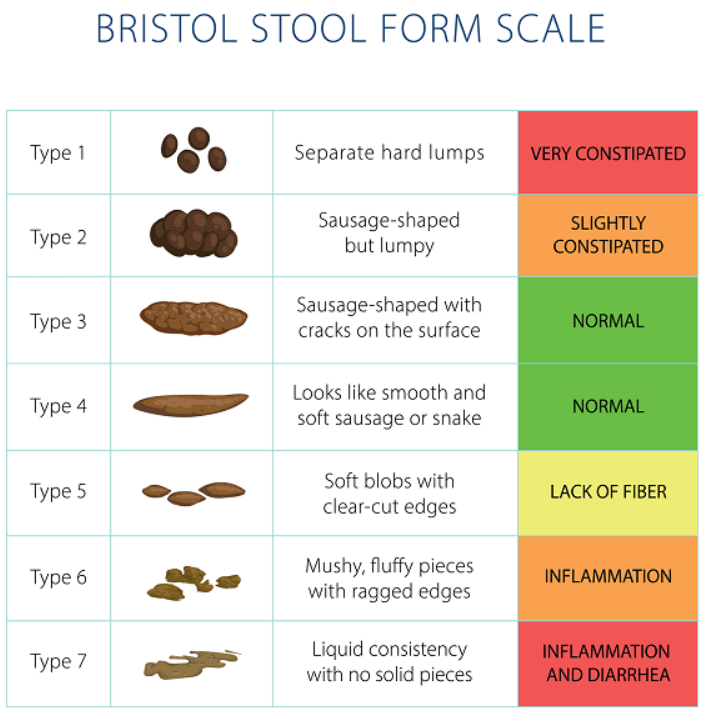
What’s Normal Down There?
The Scoop on Poop
Everybody poops. But not everyone knows what their poop is trying to tell them. From color to consistency to frequency, your poop can offer surprisingly honest insights into your health—especially your gut health.
Most important is that poop is the window to each individual’s gut microbiome. It turns out that the bacteria in our microbiomes affect almost every aspect of our health including disease prevention, mental health, and longevity. This is why doctors are using fecal transplants (seriously!) from healthy microbiomes to cure certain diseases. So let’s take a closer look—just with our minds.
What Exactly is Poop?
If you think back to what you learned about your digestive system in school, you’ll remember that everything we eat and drink moves through our digestive system from our mouths to our stomachs through our small intestines and our colons. Throughout the journey, the food is broken down and nutrients are directed to the appropriate places in our bodies. Our stool, or poop, is what’s left over at the end. This is why it is often referred to as “waste.” Roughly 75% of poop is water. The rest? A mix of fiber, live and dead bacteria, mucus, bile, undigested food bits, and sloughed-off intestinal cells. In short: your poop is the final draft of your digestive system’s rough work.
And here’s the wild part: researchers can now analyze the DNA in poop to reconstruct your diet—right down to which plants and animals you’ve eaten. Most people’s stool contains DNA from 10–40 different species. You might not remember what you ate, but your poop does. No judgment, just science.
Interesting new findings:
- More plant DNA doesn’t always mean more veggies. Ultra-processed foods like burgers and protein bars may contain ingredients from dozens of plants (which are turned into very un-plantlike substances). So, when researchers saw that obese children had more plant diversity in their stool, it was a red flag—not a green one.
- DNA sequencing of poop may soon help diagnose diet-related diseases, personalize nutrition, and track gut health more accurately than food diaries or apps.
- Frequent poopers (1–3 times/day) tend to have more short-chain fatty acids in their gut, which lower inflammation and improve blood sugar and hunger hormones.
Poop and Your Microbiome—It’s Everything!
Medical students who chose gastroenterology (digestive system specialty) 40 years ago probably didn’t know that they had chosen such a critical and expansive specialty. During the intervening years we have learned that the gut microbiome, which refers to all the microbes in our intestines, plays a huge role in most aspects of our health.
About 50% of the dry weight of our poop is bacteria—which represent the thousands of types that make up our personal microbiome. When we poop, we’re shedding trillions of bacteria, many of them no longer alive, but still offering a snapshot of what’s happening inside your digestive tract.
This is why poop is the magnifying glass that allows detectives (researchers) to understand how our microbiome is impacting our health.
- Digestive Health: The gut microbiome helps break down food, produce vitamins, and influence nutrient absorption, impacting overall digestive health.
- Immune System Development: The microbiome trains the immune system, particularly in early childhood, and protects against harmful microbes and infections.
- Metabolic Processes: The microbiome plays a role in metabolism, including regulating blood sugar and cholesterol levels, and may influence body weight.
- Mental Health: Emerging research suggests a connection between the gut microbiome and brain function, impacting mood, cognition, and potentially even mental health conditions.
- Disease Prevention: A healthy microbiome may reduce the risk of chronic diseases like diabetes, obesity, heart disease, and certain types of cancer.
- Protection Against Pathogens: The microbiome helps to create a barrier against harmful bacteria and other pathogens by outcompeting them or producing chemicals to kill them.
How Often Should We Be Pooping?
The old guidance was that anywhere from 3 times a day to 3 times a week is “normal.” But newer research says the optimal frequency is once or twice a day.
That sweet spot is linked with:
- A more diverse and beneficial gut microbiome
- Lower levels of harmful compounds in the blood
- Better glucose control and possibly lower risk of chronic diseases
Constipation (fewer than 3 times a week) can lead to protein fermentation in the gut—releasing toxins that may harm the kidneys, liver, or heart.
Too-frequent pooping (4+ times/day) may be a sign of inflammation or infection and can lead to nutrient loss.
What to Look for in the Bowl
The Bristol Stool Scale (see below) was created 28 years ago by two researchers at the Bristol Royal Infirmary in England. The scale is still a reliable clinical tool used by healthcare professionals and patients to categorize the shape and consistency of their poop. It ranges from Type 1 (hard pellets) to Type 7 (liquid). The goal? Type 3 or 4: smooth or slightly cracked, sausage-shaped, and easy to pass.

Color matters, too:
- Brown: Normal! Thank bile for that.
- Green: Usually from leafy greens or food moving too quickly through your gut.
- Yellow/greasy: Could signal fat malabsorption or gallbladder issues.
- Black or red: Could mean bleeding—see a doctor.
- White, pale, or clay-colored: Might point to a liver or bile duct issue—also see a doctor.
Other changes to watch for:
- New urgency, especially at night
- Frequent bloating or gas after meals
- A poop that floats and looks oily = excess fat
It is important to know that everybody’s “normal” is a bit different. Nobody knows your body like you do, especially since pooping is a very private function with an invite list of one. Basically, if you spot something that’s not normal for you, talk to your medical provider.
Tips for Staying Healthy and Regular
Gut health is about consistency (literally and figuratively). Here’s how to help things along:
- More fiber. Fruits, vegetables, whole grains, beans. Fiber feeds the good bacteria and keeps things moving.
- Hydration. Water is crucial for soft, passable stool.
- Movement. Physical activity stimulates digestion. Even a walk can help.
- Less ultra-processed food. Too many emulsifiers and additives can mess with your microbiome.
- Probiotics and fermented foods. Think yogurt, kimchi, kefir, and miso.
- Track your “normal.” Changes in your poop pattern are more meaningful than what’s “normal” for someone else.
The Bottom Line on Poop
Poop may not be glamorous, but it’s one of the easiest ways to get a read on your health. So don’t flush and forget—check the color, note the frequency, and give your gut what it needs to do its thing.
Because nothing says “I love you, body” like regular, smooth, easy-to-pass poops.